Table of Contents
CBSE Sample Papers for Class 12 Economics Compartment Delhi -2013
Time allowed : 3 hours Maximum marks 100
GENERAL INSTRUCTIONS
- All questions in both the sections are compulsory.
- Marks for questions are indicated against each.
- Questions No. 1-5 and 17-21 are very short-answer questions carrying 1 nick each. They are required to be answered in one sentence each.
- Questions No. 6-10 and 22-26 are? short-answer questions carrying 3 marks each. Answers to them should normally not exceed 60 words each.
- Questions No. 11-13 and 27-29 are also short-answer questions carrying 4 marks each. Answers to them should normally not exceed 70 words each.
- Questions No. 14-16 and 30-32 are long-answers questions carrying 6 marks each. Answers to them should normally not exceed 100 words each.
- Answers should be brief and to the point and the above word limit should be adhered to as far as possible.
SET I
SECTION A
Question.1. Define opportunity cost.
Answer. Opportunity cost may be defined as the value of a commodity foregone for undertaking – the given activity.
Question.2. What is budget set?
Answer. The. set of bundles of two goods that are available to the consumer given their prices and consumer’s income, is called a budget set.
Question.3. When is a good called an inferior good? .
Answer. An inferior good is one whose demand falls when income of the consumer increases and vice-versa, given other things being equal.
Question.4. Give meaning of “Returns to a Factor”.
Answer. Increase in total product that takes place as a result of employing an additional unit of a variable factor is returns to a factor.
Question.5. What is the meaning o^ “marginal cost”?
Answer. Marginal cost is the change in total cost that takes place for producing an additional unit.
In short:\(MC={ TC }_{ (n) }-{ TC }_{ (n-1) }\)
Question.6. State any three assumptions on which a ‘Production Possibilities Curve’ is based.
Answer. Assumptions. While drawing a production possibility curve, we assume certain things which are as follows:
- The volume of resources in an economy is limited and it cannot be increased.
- Technology is given. Here it is assumed that technological development and advancement is not taking place.
- With the help of given resources, only two commodities can be produced.
- There is full employment in the economy. No resources are unemployed, i.e., resources are being used fully.
Question.7. Explain the concept of ‘marginal utility’ with the help of a numerical example.
Answer. Marginal utility may be defined as the change in Total Utility that takes place by consuming an additional unit of a commodity. In other words:
\(MU={ TU}_{ (n) }-{ TU}_{ (n-1) }\)
Thus, if For example, TU of 3 units is 40 and by consuming the 4th unit, if the utility goes up to 46, Marginal Utility of the 4th unit would be 46 – 40 = 6.
In short: \(MU={ TU}_{ (n+1) }-{ TU}_{ (n) }\) = 46 – 40 = 6
Question.8. Price of a good rises from 17 per unit to 19 per unit but its demand remains unchanged. Calculate price elasticity of demand of the good.
Answer.

Question.9. Draw a total variable cost curve and total Cost curve in a single diagram.
Answer.
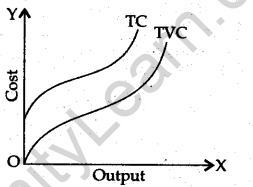
Or
Explain the behaviour, of Average Fixed Cost. Use diagram.
Answer. Average fixed cost curve is a rectangular hyperbola. With the increase in the level of output it declines but never meets x- axis because mathematically, it can not be zero. Its shape is given in adjoining figure.
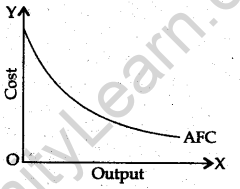
Note: The following question is for the Blind Candidates only in lieu of Q. No. 9.
State the different phases in the-behaviour of ‘Total Variable Cost’ using a numerical example.
Answer. Usually, there are two phases in the behaviour of TVC (Total Variable Cost). AS shown in a hypothetical TVC schedule, in the beginning, with the increase in output TVC declines and after a point it starts increasing. This is so because in the beginning Law of increasing returns applies and after a stage the law of decreasing returns applies.

Or
Explain the behaviour of ‘Average Fixed Cost using a numerical example.
Answer. TFC remains fixed irrespective of the level of output. It remains the same even at zero level of output, such that the AFC (Average Fixed Cost) goes on declining with the increase in the level of output. As shown in the schedule AFC goes on declining but it is never zero because it cannot be zero mathematically.

Question.10. Explain the concept of price elasticity of supply. When is the value of price elasticity of supply equal to one?
Answer. The concept of elasticity of supply explains to how much change will take place in the supply of a commodity when its price changes. Thus, the term elasticity of supply, may be defined as the degree of responsiveness of supply to a change in the price of commodity. In other words, elasticity of supply indicates the degree of change in quantity supplied in response to changes in the price of the commodity. More precisely, elasticity of supply may be defined as tire ratio of percentage change in quantity supplied to percentage change in the price of the commodity.
\({ E }_{ s }\) will be one when supply straight line if extended, meets the point of origin.
Question.11. Cigarette smoking is injurious to health. How can the government reduce its consumption but only through the normal market forces. Explain the chain of effects of government’s action.
Answer. To discourage the consumption of cigarettes, Government should levy heavy excise duty and sales tax so that the price of cigarettes goes up. Naturally, demand for its consumption will fall. This is what the government in India has been doing. In every budget additional taxes Eire levied on the production and sales of cigarettes for reducing its consumption.
Also the Government can curtail the supply of cigarettes by limiting the number of cigarettes produced by different cigarette-manufacturers.
Question.12. Explain the effect of the Allowing on supply of a good:
(i) Changes in prices of inputs, (ii) Technological advancement
Answer. (i) Changes in prices of inputs. The. increase in the price of factors of production leads to an increase in the cost of production which adversely affects the supply of a commodity. For example, when factor prices go up, the cost of production goes up. With the result the supply of a commodity will be less at a given price, The reverse will be the case when factor prices decline.
(ii) Technological advancement. Advancement in technology is a continuous process on account of research activities which constantly take place in an economy. When there is an improvement in technology, cost of production per unit declines. With the result supply increases.
Or
Explain how do the following influence supply of a good:
(i) Subsidy on production, (ii) Changes in prices of other goods.
Answer. (i) Subsidy on production. Grant of subsidy virtually reduces the cost. In the event of tax levy, subsidy reduces the tax burden. The result in this case is also reduction in cost. This will increase the supply of the good at the same price.
(ii) Changes in prices of other (related) goods. If price of a related good increases, supply of that commodity will increase and supply of initial commodity will decease and vice-versa. For example, If the price of rice increases then a farmer will , increase its production and therefore supply of wheat will decline.
Question.13. A consumer consumes only two goods X and Y and is in equilibrium. Price of good X falls. Show that it will lead to rise in demand for good X.
Answer. Equilibrium condition of two goods X and Y is : \(\frac { { MU }_{ (X) } }{ PriceofX } =\frac { { MU }_{ (Y) } }{ PriceofY } \)
As a result of fall in the price of X, MU, i.e., MU (X) will fall. This means its demand will increase. This is so because decline in the MU of a commodity means increase in its use or increase in its demand.
Question.14. State and explain the conditions of consumer’s equilibrium in the indifference curve analysis.
Answer. Conditions for consumer’s equilibrium are:
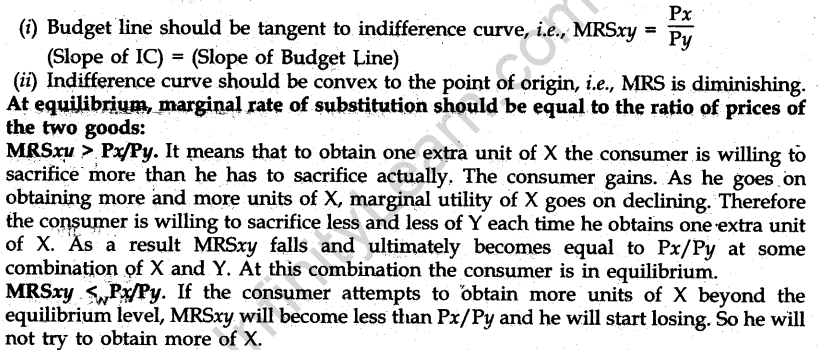
Or
State and explain three properties of indifference curves.
Answer. ’See Q. 15, 2011 (I Delhi).
Question.15. Giving reasons identify the equilibrium level of output and find profit at this output using ‘Marginal Cost and Marginal Revenue’ approach from the following:

Answer.

The equilibrium level of output is 3 units. At this level MR = MC and profit (TR – TC) ; is maximum, i.e., Rs 2.
Question.16. Explain the outcome of the following features of a perfectly competitive market: (i) Freedom to the firms to enter the industry (ii) Freedom to the firms to leave the industry
Answer. (i) Freedom to the firms to enter the industry. Under perfect competition firms have the freedom to enter the industry. As a result of this, existing firms which are earning abnormal profit will cease to earn that. New firms entering the industry will increase the supply of the product by lowering the, price, heading to a situation where a firm earns only normal profit. This means price will be the same for all the firms. .
(ii) Freedom to the firms to leave the industry. Under perfect competition firms have the freedom to leave the industry. As a result the price of the commodity is the same for all the firms. If some firms try to increase the price while the existing firms are charging the same price as before. Then the firms charging higher price will not be able to sell at all and end up making losses, because of which they will leave the industry.
SECTION B
Question.17. What is meant by ‘Consumption of fixed capital’?
Answer. The decline in the value of fixed assets due to wear and tear is known as consumption of fixed capital, i.e., depredation. This loss cannot be restored by repairs and maintenance.
Question.18. Give meaning of flow variables.
Answer. Flow are economic variables whose value can be ascertained during a period of time such as income, savings, expenditure etc.
Question.19. Name any one step the government can take through its budget to reduce the gap between the rich and the poor.
Answer. By Taxing the rich and spending the money collected on the items meant for the poor, the government can reduce the gap between the rich and the poor.
Question.20. What is barter?
Answer. Barter is a system of exchange of goods and services for some other goods and services.
Question.21. Define intermediate consumption.
Answer. Intermediate consumption means use of intermediate goods during production of final goods.
Question.22. Explain how money has solved the problem of double coincidence of wants.
Answer. See Q. 22, 2013 (I Delhi).
Or
Explain the concept of money supply.
Answer. Money supply. Money supply is the stock of money which consists of Cash and demand deposits with the public and other deposits of Central Bank of the country. Demand deposits are as goods as money.
Question.23. Calculate ‘Investment’ from the following:
(i) Equilibrium income Rs 560
(ii) Consumption expenditure at zero-income Rs 50
(iii) Marginal propensity to consume 0.7
Answer.

Question.24. Explain the distinction between ‘autonomous investment’ and ‘induced investment’.
Answer. Induced investment. The investment which is motivated by the objective of profit is known as induced investment. This investment is affected by the changes in the level of National Income. For example, if National Income goes up, this leads to an increase in the demand and for meeting the same or increasing the supply, investment is increased. Therefore, induced investment is income-elastic.
Autonomous investment. Autonomous investment is also called as independent investment because it does not relate to the level of income; the factors affecting it are other than the income. The volume of autonomous investment is the same at all levels of income. This investment is income-inelastic. Keynes has treated investment as autonomous investment. The concept of autonomous investment becomes clear looking at the table and diagram given hereafter.

As shown in the diagram investment curve II is a straight horizontal line.
Question.25. What is the basis of classifying government expenditure into ‘Revenue Expenditure’ and ‘Capital Expenditure’? Which of these types of expenditure is payment of salaries to government employees and why?
Answer. The basis of classifying government expenditure into Revenue Expenditure and Capital Expenditure is whether the expenditure results into creation of assets or reduction in the liabilities or not.
Revenue expenditure. An expenditure which does not result in either, the creation of assets or reduction of liability is called revenue expenditure. Expenditure incurred on payments of salaries, pensions etc. are the examples of revenue expenditure. This is so because they do not create any assets.
Capital expenditure. An expenditure which either results in the creation of assets or reduction in liabilities is capital expenditure. Expenditure incurred on construction of buildings, roads, bridges etc. and buying land are the examples of capital expenditure.
Payment of Salaries to Government Employees is a revenue expenditure, because it does not either create an asset or reduce a liability.
Question.26. In India, exchange rate of U.S. Dollar has risen considerably. What is its likely impact on Indian exports and why?
Answer. See Q. 30, 2012 (Comptt. I Outside Delhi).
Question.27. Explain the “Bankers’ Bank” function of central bank.
Answer. See Q. 28, 2012 (I Delhi).
Question.28. Explain how government can influence allocation of resources through government budget.
Answer. An important objective of Government budget is to allocate resources for accomplishing socioeconomic objectives of the Government. There are number of projects and activities for which resources are allocated. Government can influence allocation of resources through (i) tax concessions, subsidies etc. arid (ii) by directly producing goods and services. Resources may be allocated for increasing investment,reducing income inequalities and providing better health and education facilities.
Explain the distinction between fiscal deficit and primary deficit.
Ans. Fiscal deficit is equal to the excess of total expenditure over the sum of revenue and capital receipts. On the other hand, Primary deficit is the excess of interest payments over fiscal deficit. In short:
Fiscal Deficit = Total Budget Expenditure – Revenue Receipts + Capital Receipts excluding Borrowings Primary Deficit = Fiscal Deficit – interest payments
Question.29. Distinguish between the autonomous transactions and the accommodating transactions in the Balance of Payments. What is the significance of this distinction?
Answer. Autonomous transactions. Autonomous transactions in the Balance of Payments (BOP) mean those items which are motivated by* profit consideration. Therefore, those items of international economic transactions which are motivated by profit consideration are autonomous items such as import and export of goods and services and inflow and outflow of capital items. Autonomous items are independent of the state’s or the country’s balance of payments.
Accommodating transactions. Accommodating items correct the disequilibrium in the balance of payments. BOP accounts may reflect deficit or surplus. These situations are corrected by the government by injecting or withdrawing funds. These transactions pertain to funding of or withdrawal from the official reserve system using gold, special drawing rights and foreign exchange reserves. When there is a deficit in the BOP accounts this is rectified through accommodating items.
Question.30. Calculate (a) Private Income and (b) Gross Domestic Product at Factor Cost
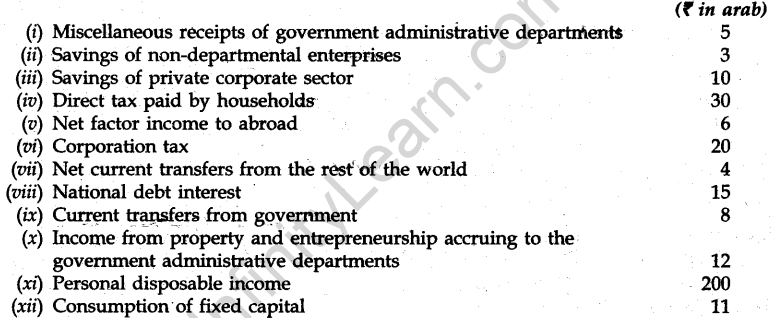
Answer.

Question.31. Giving reason explain how should the following be treated in estimating national income:
(i) Electricity consumed by a firm’
(ii) Pension paid to the retired employees
(iii) Free treatment of the poor in hospitals
Answer. (i) Electricity consumed by a firm will not be included in national income because it is an intermediate product and if included will create the problem of double counting as electricity produced and electricity consumed.
(ii) Pension paid to the retired employees is not included in national income because it has already been included as a part of compensation of employees while they were in service.
(iii) Free treatment of the poor in hospitals is not included in national income because poor people are provided free treatment not in return of any productive service. This is a transfer payment.
Or
Explain the concept of “real income”. Explain why, due to the presence of externalities, real national income in itself cannot be treated as a true index of welfare.
Answer. Real income. See Q. 27, 2011 (Comptt. I Delhi).
Question.32. Explain the meaning of inflationary gap and deflationary gap with the help of diagrams.
Answer. If equilibrium is established after the full employment level of output, it is a situation where aggregate demand is more than aggregate supply. The gap between the two is inflationary gap as shown by EF in the adjacent diagram. This gap can be rectified by increasing the level of aggregate supply.
When aggregate demand and aggregate supply are in equilibrium at less “than the full employment level of output, this is a situation of deficient demand.
This happens when aggregate demand in the economy is not sufficient to ensure that level of output which can give employment to all those who are willing to work. Aggregate demand falls short of aggregate supply at full employment level of output by a certain amount, which is called deflationary gap. The extent of deficiency in demand (deflationary gap, i.e., EF) at the full employment level is shown in the diagram.
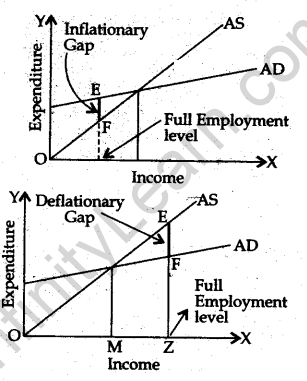
Or
Note: The following question is for the Blind Candidates only in lieu of Q.No.32.
Explain the meaning of inflationary gap and deflationary gap. Explain any one measure by which these gaps can be reduced.
Answer. Please read answer to above Q. 32.
Bank rate. Bank rate is the rate of interest which central bank charges from commercial, banks for giving them loans. If bank rate is increased, the rate of interest for general public also goes up and this reduces the demand for credit by fire public for investment arid consumption. Therefore, for controlling the situation of inflationary gap, bank rate is increased. On the other hand, for controlling the situation of deflationary gap bank rate should be reduced so that interest rate goes down leading to an increase in autonomous investment.
SET II
Note: Except for the following questions, all the remaining questions have been asked in Set I.
SECTION A
Question.1. Define budget line.
Answer. The budget line graphically shows all the bundles of goods that can be bought by spending , the entire income.
Question.4. What is the meaning of ‘Marginal Product’?
Answer. Marginal Product is the change (increase) in total product which takes places as a result of employing an additional unit of variable input.
Question.7. Price of a product falls from Rs 10 to Rs 9 per unit. As a result its demand rises from 9 units to 10 units. Calculate price elasticity of demand using expenditure approach.
Answer.

According to expenditure approach, there is no change in total expenditure.
Question.12. A consumer consumes only two goods X and Y and is in equilibrium. Price of good X rises, Show that it will lead to fall in demand for good X.
Answer. Equilibrium in the case of goods X and Y is: \( \frac { { MU }_{ X } }{ PriceofX } =\frac { { MU }_{ Y } }{ PriceofY } \)
When price of X increases, this leads to increase in the \({ MU }_{ X }\) . Increase in the MU of a commodity means fall in its demand. This means a fall in the demand for good X.
Question.14. Giving reasons identify the equilibrium level of output and find profit at this output using ‘Marginal Cost and Marginal Revenue’ approach from the following:

Answer.

The equilibrium level of output is 4 units because at this level MR = MC and the profit (TR – TC) is zero, i.e., not negative.
SECTION B
Question.17. Give meaning of ‘Stock’ variables.
Answer. Those economic variables whose value relates to a point of time are stock variables such as wealth, capital etc.
Question.21. Define ‘resident’.
Answer. Resident is a person who is living in the country, earning a living within the boundary lines of a country.
Question.22. Calculate Marginal Propensity to Consume from the following:
(i) Equilibrium income Rs 350
(ii) Consumption expenditure at zero income Rs 20
(iii) Investment
Answer.

Question.32. Calculate (a) Private Income (b) National Income:
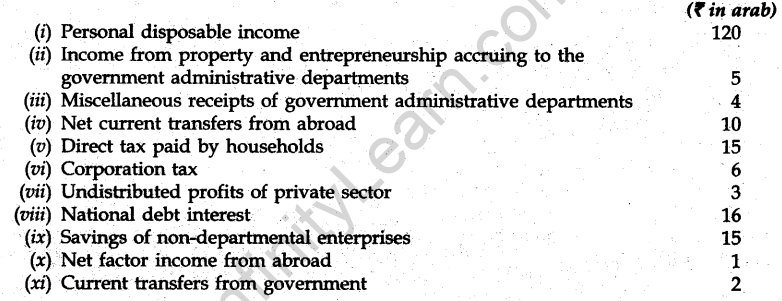
Answer. (a) Private Income = Personal disposable income + Miscellaneous receipts of government administrative departments + Direct tax paid by households + Corporation tax + Undistributed profits of private sector = (i) + (iii) + (v) + (vi) + (vii)
= 120 + 4 + 15 + 6 + 3 = Rs 148 arabs
(b) National Income = Private income + Income from property and entrepreneurship accruing to the government administrative department – Net current transfers from abroad – National debt interest – Current transfers from government = Private income + (ii) – (iv) – (viii) – (xi)
= 148 + 5 – 10 – 16 – 2 = 153 – 28 = Rs 125 arabs
SET III
Note: Except for the following questions, all the remaining questions have been asked in Set I and Set II.
SECTION A
Question.3. What will be the behaviour of marginal revenue in a market for a product where a firm can sell any quantity at the given price?
Answer. MR will be a straight horizontal line as shown in the diagram.

Question.5. Define indifference map.
Answer. The indifference map represents a family of indifference curves with higher indifference curves denoting higher level of satisfaction.
Question.7. Price of a good rises from Rs 5 to Rs 6 per unit but it had no effect on demand of that good. Calculate price elasticity of demand of the good.
Answer.

Question.13. A consumer consumes only two goods X and Y and is in equilibrium. Price of good Y rises.Show that it will lead to fall in demand for good Y.
Answer. For two goods X and Y, the equilibrium condition is:
\( \frac { { MU }_{ X } }{ PriceofX } =\frac { { MU }_{ Y } }{ PriceofY } \)
If MU of a commodity increases, this means fall in its demand and vice-versa. Therefore, when the price of Y increases, its MU also increases. This means fall in the demand for commodity Y.
Question.16. Giving reasons identify the equilibrium level Of output and find profit at this output using the Marginal Cost and Marginal Revenue approach from the following:

Answer.

The equilibrium level of output is 2 units. At this level MR = MC. At this level profit (TR – TC) is Rs 1. Profit at 1 unit is also Rs 1, but at that level MR is not equal to MC. At all the other levels MC > MR.
SECTION B
Question.20. What is depreciation?
Answer. Depreciation is the decline in the value of the capital assets due to use and wear and tear.
Question.21. Define investment.
Answer. Creation of physical assets for increasing production capacity is termed as investment.
Question.26. Calculate equilibrium level of income from the following:
(i) Consumption expenditure at zero income Rs 40
(ii) Marginal Propensity to Consume 0.8
(iii) Investment Rs 80
Answer.

Question.31. Calculate (a) Private Income and (b) Gross Domestic Product at Market Price:

Answer.




